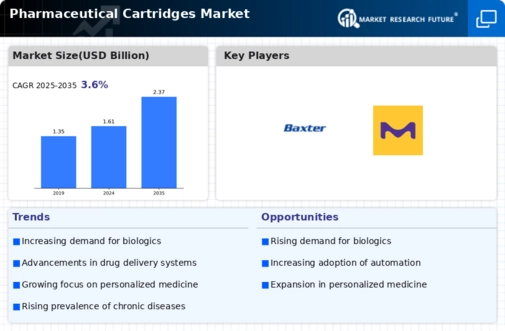Pharmaceutical Cartridges Size
Pharmaceutical Cartridges Market Growth Projections and Opportunities
The pharmaceutical cartridges market is expected to reach USD 2.06 billion by 2032 at 3.6% CAGR. The Pharmaceutical Cartridges Market is shaped by many aspects that affect its growth. Drug delivery systems depend on pharmaceutical cartridges to package and dispense injectable medications. Demand for parenteral drug delivery, cartridge material and design advances, and biopharmaceutical and injectable drug manufacturing expansion drive market dynamics.
Pharmaceutical Cartridges Market dynamics are shaped by R&D. Pharmaceutical packaging companies create and refine cartridge technology to fulfill pharmaceutical producers' needs. Advances in materials like glass and plastics and cartridge design, such as pre-filled and ready-to-use alternatives, increase pharmaceutical cartridge utility and market dynamics. Innovation and efficiency in cartridge solutions fuel industrial growth.
Technological advances also affect pharmaceutical cartridge markets. Advanced cartridge plastics and coatings improve drug stability and compatibility with many drug formulations. Manufacturing innovations like automated filling and assembly increase product quality and cost. These technological advances improve pharmaceutical cartridge functionality and help pharmaceutical makers package drugs safely and efficiently, growing the market.
Pharmaceutical cartridge market dynamics depend on regulations and quality. Pharmaceutical product safety, efficacy, and integrity depend on strict regulatory standards, which are essential for market confidence. Pharmacopeial standards and GMP compliance affect pharmaceutical businesses' purchasing decisions. Pharmaceutical cartridge manufacturers strategically traverse regulatory landscapes to preserve compliance and product quality, influencing industry dynamics. Pharmaceutical cartridge market dynamics are also affected by economic variables. Economic conditions affect pharmaceutical budgets and spending habits, making high-quality cartridge solutions affordable and accessible for drug producers. Pharmaceutical packaging may become cost-conscious during economic downturns, affecting industry growth. In contrast, a developing economy may boost drug discovery and manufacture, increasing demand for advanced pharmaceutical cartridges.
Pharmaceutical firms seek cartridge solutions that are compatible with a variety of medication formulations, easy to use, and compliant with regulatory standards as awareness of the need of efficient and dependable drug packing grows. Pharmaceutical firms favor cartridges with low extractables and leachables, robust production methods, and sustainable packaging, stimulating innovation.







Leave a Comment